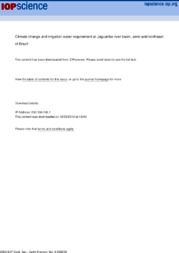Climate change and irrigation water requirement at Jaguaribe river basin, semi-arid northeast of Brazil.
Climate change and irrigation water requirement at Jaguaribe river basin, semi-arid northeast of Brazil.
Author(s): GONDIM, R.; CASTRO, M. A.; MAIA, A.; EVANGELISTA, S.
Summary: Summary: Climate change has a potential to impact rainfall, temperature and air humidity, which have relation to plant evapotranspiration and crop water requirement. The purpose of this research is to assess climate change impacts on irrigation water demand, based on future scenarios derived from the PRECIS (Providing Regional Climates for Impacts Studies), using boundary conditions of the HadCM3 submitted to a dynamic downscaling nested to the Hadley Centre regional circulation model HadRM3P. Monthly time series for average temperature and rainfall were generated for 1961-90 (baseline) and the future (2040). The reference evapotranspiration was estimated using monthly average temperature. Projected climate change impact on irrigation water demand demonstrated to be a result of evapotranspiration and rainfall trend. Impacts were mapped over the target region by using geostatistical methods. An increase of the average crop water needs was estimated to be 18.7% and 22.2% higher for 2040 A2 and B2 scenarios, respectively. Objective ? To analyze the climate change impacts on irrigation water requirements, using downscaling techniques of a climate change model, at the river basin scale. Method: The study area was delimited between 4º39?30? and 5º40?00? South and 37º35?30? and 38º27?00? West. The crop pattern in the target area was characterized, regarding type of irrigated crops, respective areas and cropping schedules, as well as the area and type of irrigation systems adopted. The PRECIS (Providing Regional Climates for Impacts Studies) system (Jones et al., 2004) was used for generating climate predictions for the target area, using the boundary conditions of the Hadley Centre model HadCM3 (Johns et al., 2003). The considered time scale of interest for climate change impacts evaluation was the year of 2040, representing the period of 2025 to 2055. The output data from the climate model was interpolated, considering latitude/longitude, by applying ordinary kriging tools available at a Geographic Information System, in order to produce thematic maps.
Publication year: 2009
Types of publication: Abstract in annals or event proceedings
Unit: Embrapa Environment
Keywords: Irrigação, Mudança Climática
Observation
Some of Embrapa's publications are published as ePub files. To read them, use or download one of the following free software options to your computer or mobile device. Android: Google Play Books; IOS: iBooks; Windows and Linux: Calibre.
Access other publications
Access the Agricultural Research Database (BDPA) to consult Embrapa's full library collection and records.
Visit Embrapa Bookstore to purchase books and other publications sold by Embrapa.

